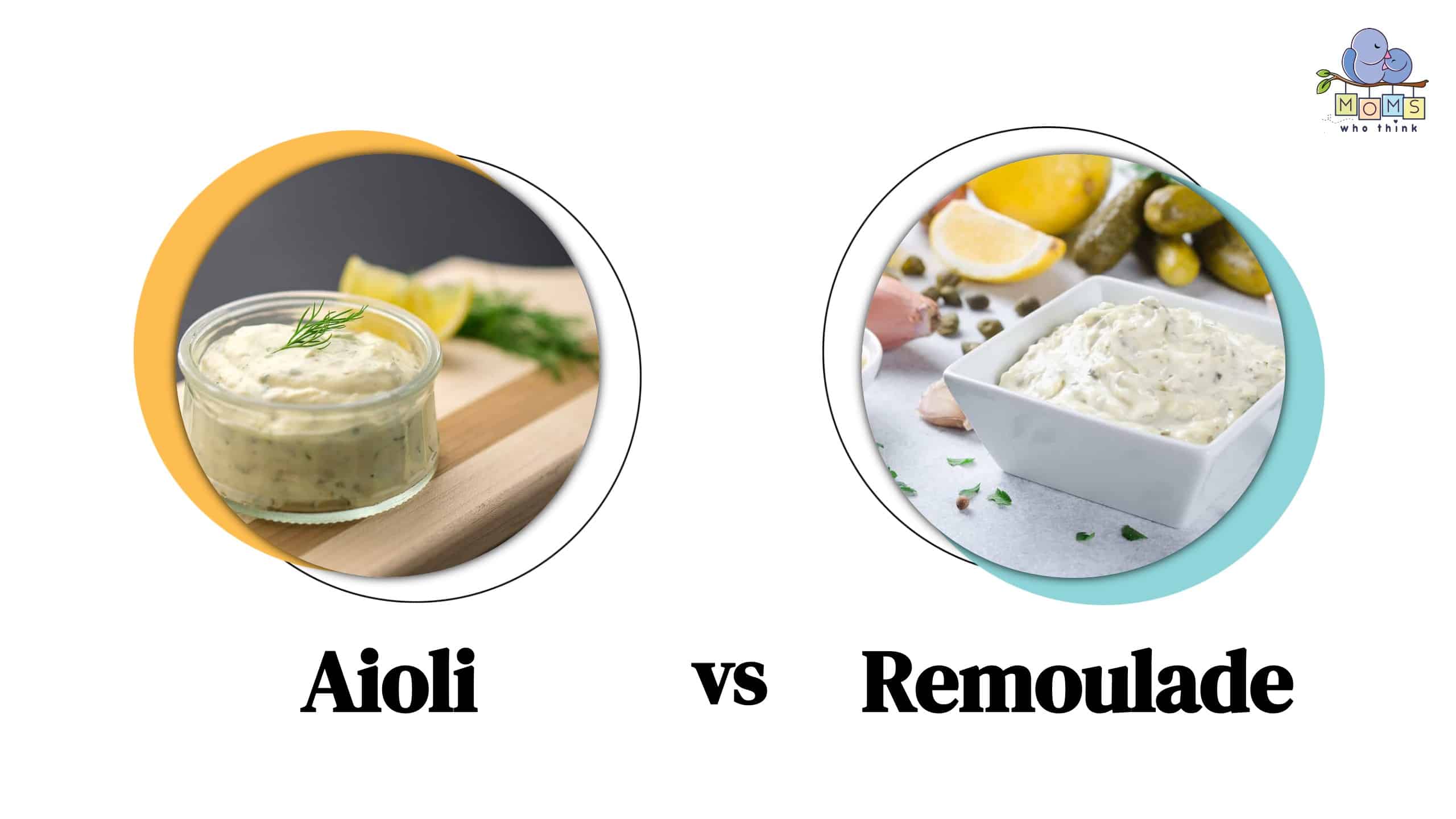Though both terms are often used interchangeably, there are several fundamental differences between remoulade vs. aioli. Let's dive into the differences including what remoulade and mayo are, where they originate from, how to use each, substitutes for each, and their key differences.
Remoulade vs. Aioli: What is the Difference?
The primary difference between remoulade and aioli is their ingredients. Remoulade is a versatile sauce that typically combines mayonnaise, whole grain or Creole mustard, capers, and a spicy kick from ingredients like cayenne pepper or hot sauce. On the other hand, aioli is a Mediterranean-inspired condiment that primarily consists of garlic-infused mayonnaise, often enhanced with lemon juice and olive oil. While both sauces share a mayonnaise base, remoulade offers a tangy, spicy twist, whereas aioli delivers a rich, creamy garlic flavor.
In order to really understand the difference between remoulade vs. aioli, it’s important to understand the definitions of both and learn the different ways each can be prepared.
Remoulade vs. Aioli Nutrition: Comparing Calories, Fat, Protein, and More
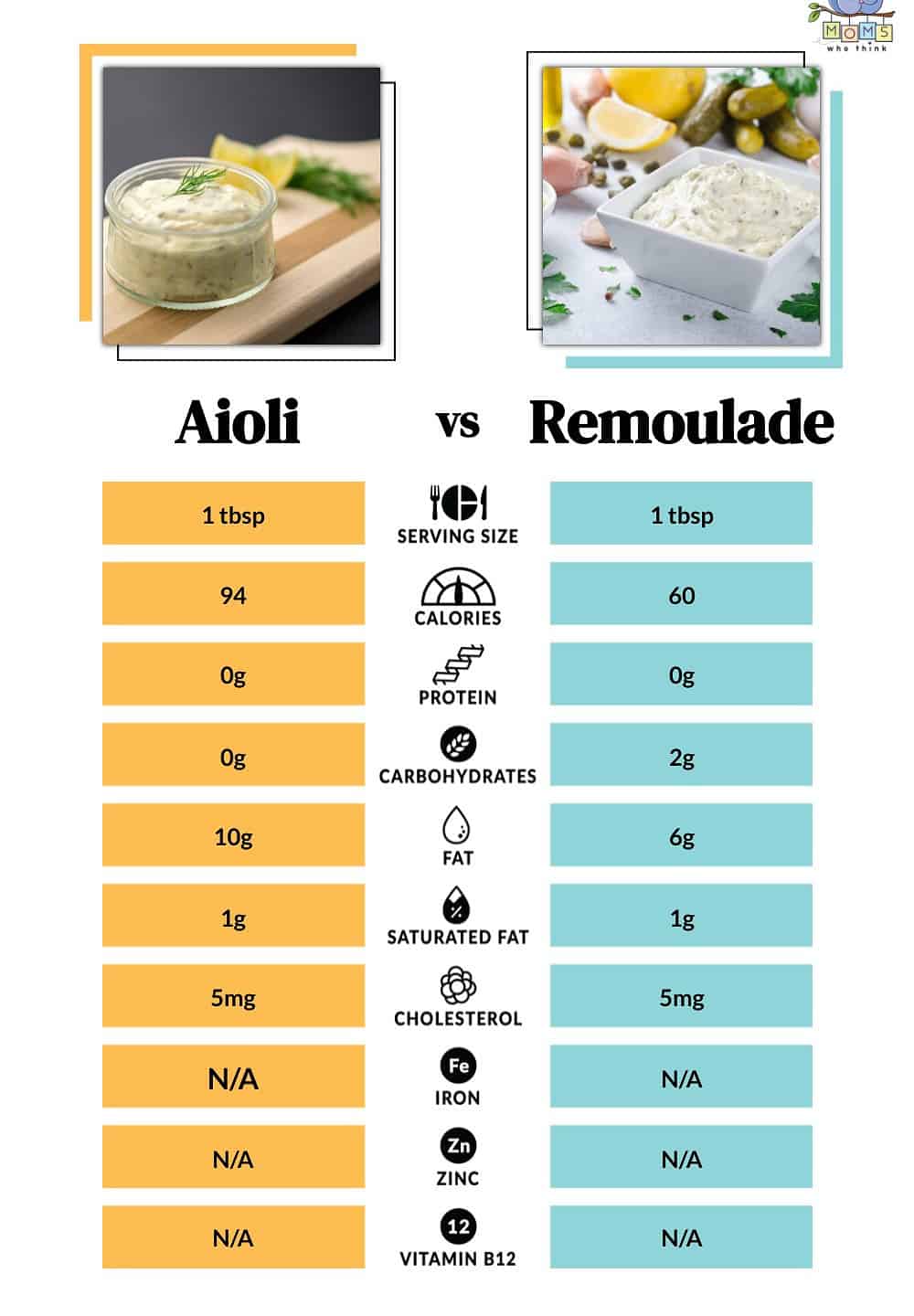
A nutrition comparison of remoulade and aioli
©
Generally, aiolis are a little heavier in calories per serving and fat content. However, keep in mind that since both sauces have a mayonnaise base, their calories will be very dependent on what kind (and how much) of mayonnaise is used. Thus, whether purchasing different brands or making these sauces at home nutritional content can vary.
What is Remoulade?
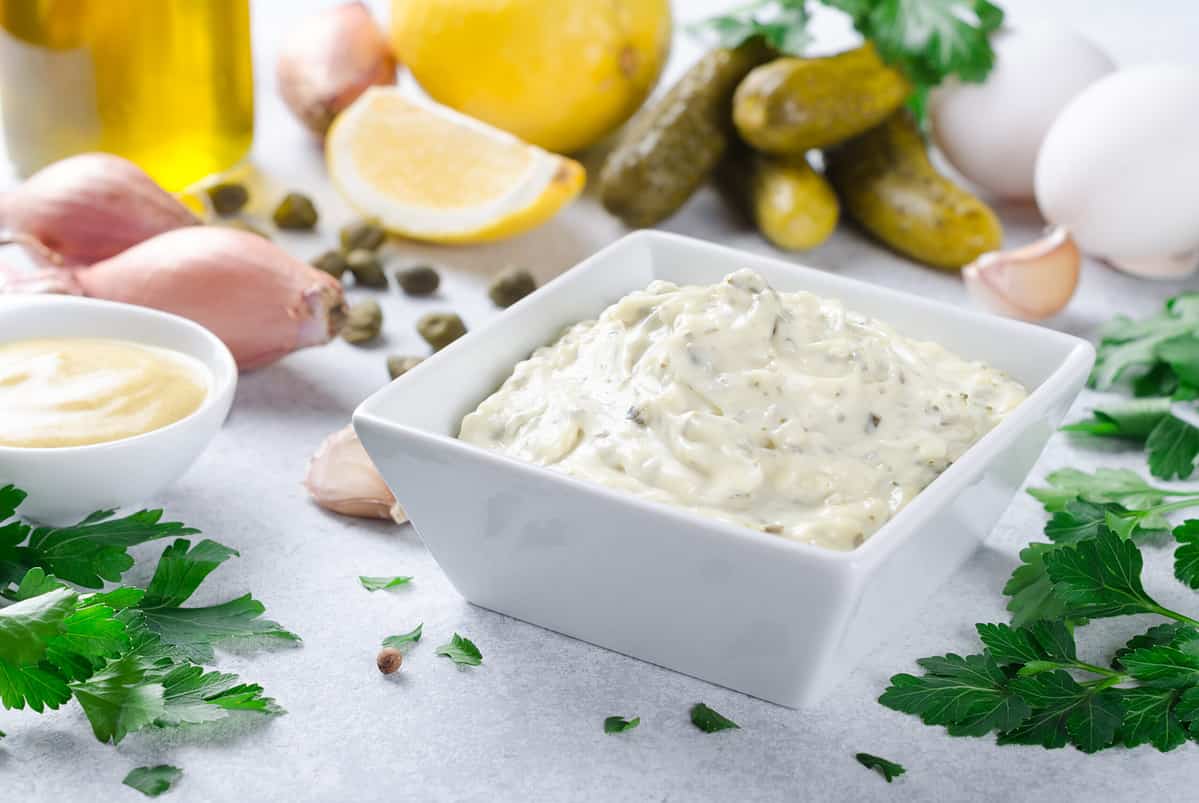
Homemade traditional French sauce remoulade
©losinstantes/Shutterstock.com
Essentially, remoulade is a cold sauce of French origin. Somewhat similar to tartar sauce, it’s typically more yellowish, is often flavored with curry, and it is known to contain chopped piccalilli or pickles. Some variations may also include paprika, horseradish, capers, anchovies, and various other ingredients.
When it first originated, it was used for cooking meats. However, in the current times, it’s often used as a condiment that pairs well with plaice, sole, and seafood cakes.
- The must-have convenient reference guide for every home cook!
- Includes more than 8,000 substitutions for ingredients, cookware, and techniques.
- Save time and money on by avoiding trips to grab that "missing" ingredient you don't really need.
You’ll often see it served in France and other European countries. It’s also served in the United States, typically in Louisiana Creole cuisine. There, it’s often paired with french fries, roast beef, and as a hot dog condiment. Often, fried soft-shell crab sandwiches may involve remoulade as a main ingredient. Many people also pair it with turkey sandwiches.
How It’s Made in Different Countries
Remoulade is usually prepared differently based on the country in which it’s served. You can generally expect the following:
French – Prepared with various herbs, like parsley and chives, and may also include capers, dried cornichons, and sometimes anchovies.
Danish – Danish remoulade typically has a sweet-sour taste. Their version often involves cabbage, pickled cucumber, sugar, and curry powder.
United States – The version that you can typically buy at the store in Louisiana and the U.S. often has mayonnaise, chopped vegetables, salt, pepper, and cayenne pepper.
What is Aioli?
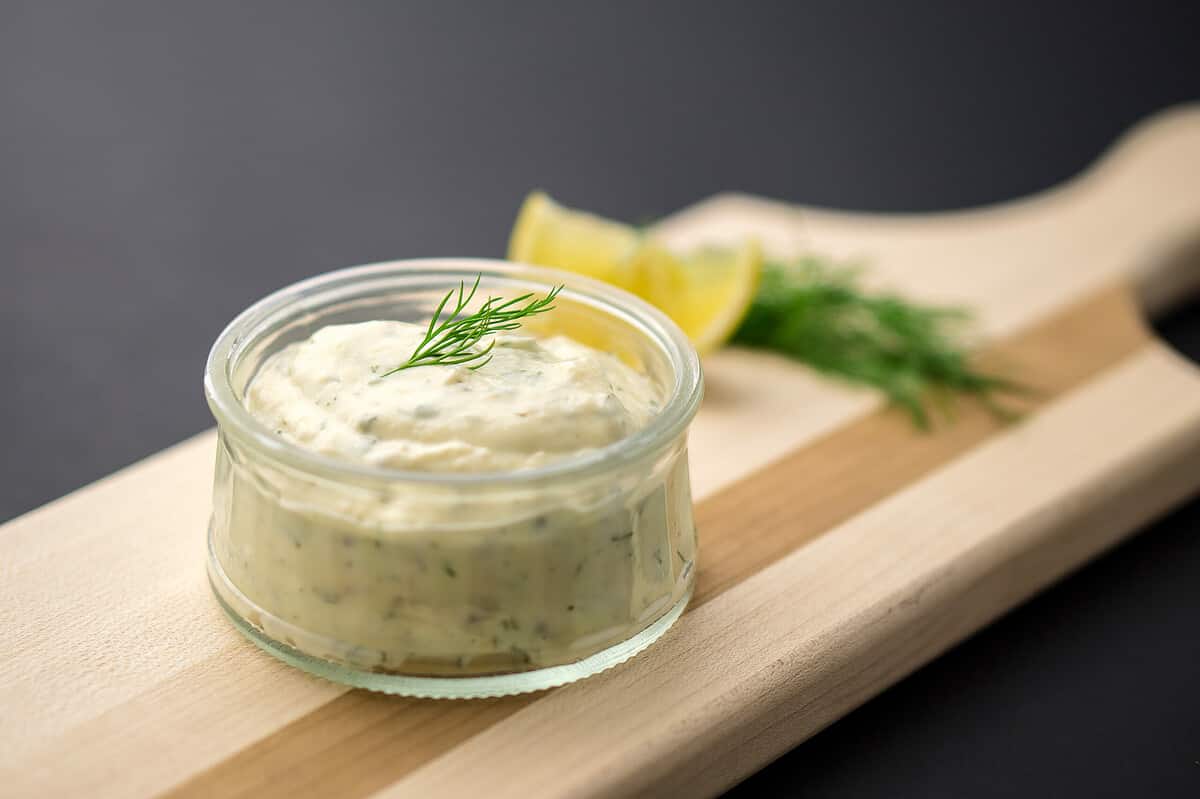
Aioli makes for a great dipping sauce for many tasty appetizers.
©iStock.com/Louno_M
Aioli is also a cold sauce, but the difference between remoulade vs. aioli is that aioli's main components include an emulsion of garlic and olive oil. The sauce is mostly found in the Mediterranean and European countries, including France, Italy, and Spain.
Although the main ingredients in aioli are olive oil and garlic, there are many variations depending on the preparer or country. Some aiolis may include garlic mayonnaise, egg yolks, lemon juice, and other seasonings. In France, it often includes mustard. Aioli became more common in the United States in the 1990s. Here, most people refer to any flavored mayonnaise as an aioli.
There are many variations, but aioli purists will tell you that there shouldn’t be any other seasonings other than garlic.
How Aioli Is Served
In countries like Italy, aioli is served with fish soup, seafood, and croutons. It may also be served with potatoes.
In Provençal cuisine, aioli is often served with fish, canned tuna, and other seafood. Aioli plays an important part in this area of the world. It’s traditional to serve it with snails on Christmas Eve and alongside cod on Ash Wednesday.
Spain restaurants will often serve aioli with grilled snails, grilled meat, rabbit, lamb, vegetables, and boiled cod.
What Are Substitutes for Aioli?
Some people don’t want to choose between remoulade vs. aioli, but they like the consistency and want to try something similar. The good news is that there are several different substitutes for aioli that you can try.
Mayonnaise
Some historians believe that aioli was the precursor to mayonnaise, so why not use mayonnaise instead? While mayonnaise will often lack the zestiness of real aioli, it does often include common ingredients, like vinegar, olive oil, and a raw egg. To make it more aioli-like, mix in a teaspoon of mustard, crushed garlic, and lemon juice.
Tartar Sauce
You’ll get a similar consistency to aioli with tartar sauce that typically includes onions, dill pickles, olives, capers, and sweet pickle relish. Add lemon and chives for that extra zest.
Thousand Island Dressing
Typically a mixture of ketchup and mayonnaise, thousand island dressing has a similar consistency to aioli. Make this dressing close to aioli by adding spices like cayenne, pickle relish, onions, and chives.
Skordalia
If you’re looking for a dipping sauce, then you use Skordalia as a direct substitute, especially when you’re eating meatballs, crudites, and fish. Like aioli, skordalia often includes garlic and olive oil.
Tzatziki
As a healthier alternative, consider Tzatziki because it’s not an emulsified sauce like aioli or mayonnaise. Still, it’s delicious for dipping seafood, bread, and veggies.
Pesto
Pesto is good for your health, and it’s delicious on many different meals. The texture of pesto is similar to aioli, but it is a different color and offers a unique taste.
- The must-have convenient reference guide for every home cook!
- Includes more than 8,000 substitutions for ingredients, cookware, and techniques.
- Save time and money on by avoiding trips to grab that "missing" ingredient you don't really need.
Hummus
This Middle Eastern delicacy is made with chickpeas and tahini, but it often also includes garlic and olive oil, like aioli. Plus, its smooth and creamy texture makes it a great alternative to aioli.
Sour Cream
Another alternative that has a similar texture to aioli is sour cream. However, it doesn’t have the same complex flavor profile. To create a closer match, add lemon juice, crushed garlic, and mustard, and you’ll be in business.
Cream Cheese
You may not think of cream cheese as a suitable replacement, but it has a thick consistency, and it's also a healthy alternative. To give it more zest, add mayonnaise, garlic, and lemon juice.
Greek Yogurt
Another healthy substitute, Greek yogurt will have a similar texture to aioli. However, to match the flavor, you’ll want to add lemon juice, garlic, and mustard.
Avocado
Crushed avocado will give you a nice texture and consistency, and it’s delicious on its own. However, you can kick it up a notch with olive oil, mustard, lemon juice, and garlic.
Ways to Use Remoulade
The thing about the debate of remoulade vs. aioli is that you can use both as tasty dipping sauces. There are a variety of ways to use both of these options.
Remoulade is great with meals that involve seafood, cold meats, and fried foods. However, that’s just the tip of the iceberg. Remoulade is great for dipping many finger foods or drizzling it on top of dishes including…
- Fried fish
- Crab cakes
- BLT sandwich spread
- Hot dogs
- Hamburgers
- Fried pickles
- Asparagus
- Grilled salmon
- French fries
- Potato salad
Ways to Use Aioli

Cook the burger patty in aioli and use it as a dipping sauce for the fries.
©Dejan Stanic Micko/Shutterstock.com
It’s fair to say that we tend to hear more about aioli, and that’s because it can be used for a variety of dishes and applications. Some ways to use aioli include…
Corn Fritters – Add a cup of aioli as a side with these corn fritters and it will change your life.
French Fries – Use it as a dipping sauce or use it to flavor the fries while they're cooking.
Burgers – To give your burgers a savory flavor, coat the buns in aioli.
Quesadilla – Use aioli as a dipping sauce or mix it in with the meat. Cook the quesadilla, then toss it with aioli sauce until covered.
Wings – Dip your wings in spicy aioli sauce.
Cauliflower Bites – Coat the entire bites in delicious aioli sauce.
Zucchini Bites – Zucchini can sometimes use some help in the flavor department, and aioli can help.
Meatballs and Chicken Strips – Both appetizers are great with a tasty aioli sauce.
Crab Cakes and Salmon – Most seafood can benefit from some tasty aioli sauce.
Tacos – Coat the meat with aioli sauce while cooking, and add to the tacos for a flavor punch.
Conclusion
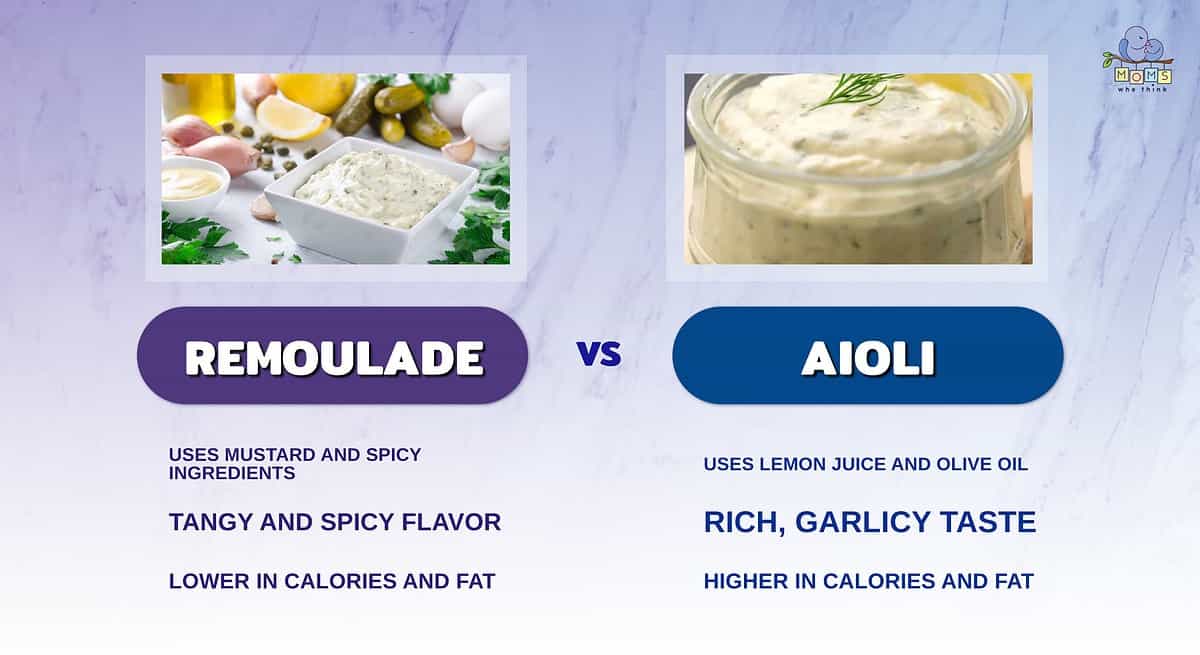
- Both remoulade and aioli are mayo-based sauces, yet they have distinct differences in ingredients. Remoulade uses mustard and spicy ingredients, such as hot sauce, while aioli uses lemon juice and olive oil.
- Aioli has a rich, garlicy taste thanks to its supplemental ingredients and use of garlic-infused mayo. Remoulade has a tangy, spicy flavor that you're sure to never forget.
- Aioli is higher in calories and fat compared to remoulade, making it a poorer choice for those on a diet. Using reduced-fat mayo can help cut down the fat and calories, although it may change the flavor profile of the sauce.

Corn Fritters Recipe
- Total Time: 20 Minutes
Description
If you are familiar with Southern cooking, you know that corn fritters are a popular snack made with a batter of flour or cornmeal, corn, eggs and milk. If you are not familiar with Southern cooking, and did not known what corn fritters are, now you do. Enjoy!
Ingredients
- 3 Egg Yolks
- 1 2/3 Cups Cooked or Canned Whole Grain Corn
- 1/2 Teaspoon Salt
- 1/8 Teaspoon Pepper
- 1/4 Cup Sifted All-purpose Flour
- 3 Egg Whites
- 6 Tablespoons Vegetable Oil
Instructions
- Beat egg yolks until light, then add corn, and next 3 ingredients.
- Fold in stiffly beaten egg whites. Drop by the spoonful into hot oil in a skillet.
- Cook on both sides until brown and done.
- Prep Time: 10 Minutes
- Cook Time: 10 Minutes
- Category: Side Dish
- Method: Pan-frying
- Cuisine: American
Now that you have a better understanding of remoulade vs. aioli, it’s time to add these delicious sauces as a side for your next meal. Prepare either in just the right way, and it will create a mix of flavors that you won’t soon forget.
- The must-have convenient reference guide for every home cook!
- Includes more than 8,000 substitutions for ingredients, cookware, and techniques.
- Save time and money on by avoiding trips to grab that "missing" ingredient you don't really need.
